Globally Important Agricultural Heritage Systems (GIAHS) related to tea
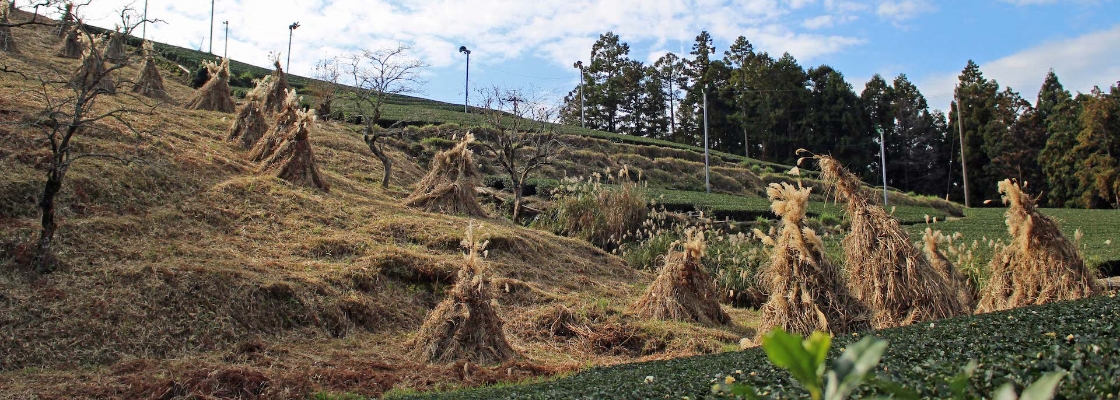
MENU
Name of System: Traditional Tea-grass Integrated System in Shizuoka (Shizuoka’s CHAGUSABA farming method)
静冈茶草场复合系统
Area: Kakegawa City, Kikugawa City, Shimada City, Makinohara City and Kawanehon Town, Japan
Date of recognition: 3 March 2013
Sustainable agriculture and environmental conservation
The Chagusaba farming method is a farming method traditionally practiced in Shizuoka Prefecture using grass mulch. It is an example of circular agriculture that harmonizes humans’ relationship with nature to preserve the environment and protect biodiversity.
Cha (茶) means tea, Gusa/Kusa (草) means grass, and Ba (場) means place. Chagusaba (茶草場) refers to the semi-natural grasslands around tea fields. The Chagusaba farming method makes use of natural resources by cutting pampas or bamboo grasses that grow around the tea fields and laying them in the furrows between the tea fields. These grasses used in the tea fields are called Chagusa (茶草).
The Chagusaba farming method makes use of natural resources by cutting pampas or bamboo grasses that grows around the tea fields and laying it in the furrows between the tea fields. The places where pampas or bamboo grasses grow around the tea fields are called “Chagusaba”, and the pampas or bamboo grasses are called “Chagusa”. Chagusaba farms are semi-natural grasslands tended by humans.
Tea farmers cut pampas or bamboo grasses in autumn and winter, bundle the harvested grasses, and dry the bundles around the tea fields or on the slopes of the mountains for a while. The bundles of grasses which shaped a delta cone are called “kapposhi”.
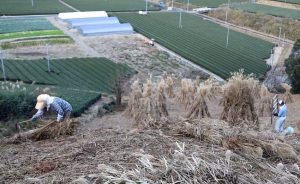
Producers cutting grass and making kapposhi in Kakegawa City (November 2020)
The cut pampas grass is finely cut with a machine and laid in the furrows of the tea fields. The Chagusa laid in the furrows is fluffy, and looks like a Japanese futon (like a duvet). The Chagusa gradually breaks down to become compost. In addition, the laying of Chagusa makes it difficult for weeds to grow and prevents the soil from being displaced by rainwater.
Some tea farmers compost the cut Chagusa, mix it in rice husks during the summer, and allow the compost to ferment, then spread the compost on the tea fields from December to January.
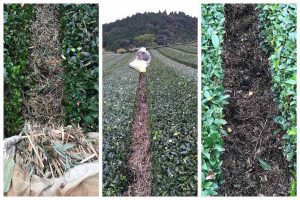
Chagusa (tea glass) laid in furrows becomes compost over time in Kakegawa City (November 2016)
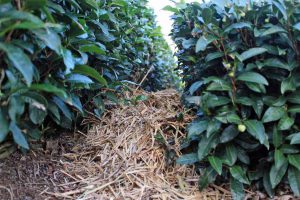
Fluffy duvet-like Chagusa in Kakegawa City (November 2017)
Chagusaba farming method that protects biodiversity
By cutting the tall pampas grass around the tea fields, small animals and plants are given access to sunlight allowing them to thrive. At Mt. Awagatake in Higashiyama, Kakegawa City, where the Chagusaba Farming Method is actively practiced, species such as the Kakegawa Fuki Locust (Parapodisma awagatakensis) and rare animals and plants such as golden orchids live in abundance. In addition, cutting tall grasses contributes to mountain conservation by preventing the mountain from becoming overgrown.
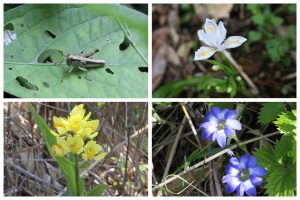
The Chagusaba farming method is hard work for tea farmers. In Japan, it is becoming more difficult to continue Chagusaba farming every year due to fluctuations in wholesale tea leaf prices, the aging of producers, and a decrease in successors.
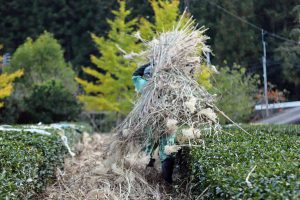
Producer transporting Chagusa in Kakegawa City (November 2020)
Shizuoka’s Chagusaba farming method has been recognized as a Globally Important Agricultural Heritage System (GIAHS) in four cities and one town: Kakegawa City, Kikugawa City, Shimada City, Makinohara City, and Kawanehon Town in 2013.
Grass mulch farming was once conducted all over Japan. However, it is a burden on tea farmers. Thus, the number of tea farmers who conduct grass mulch methods has been decreasing.
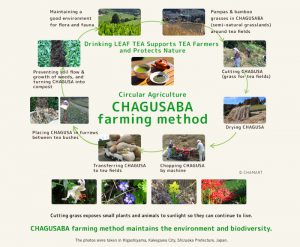
Higashiyama tea is fukamushicha (deep steamed green tea) which is cultivated by the Chagusaba farming method.
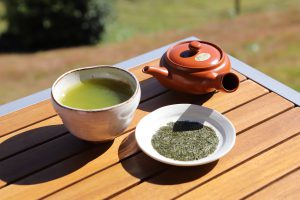
Higashiyama tea at Kapposhi Terrace, Kakegawa City, Shizuoka Prefecture (October 2019)
The Biodiversity Contribution Sticker of the Council for the Promotion of “Chagusaba in Shizuoka” as a GIAHS, indicates the degree of contribution to biodiversity conservation by the number of tea leaves.
The number of tea leaves increases, the larger the percentage of the overall the area of the tea garden dedicated to the Chagusaba farming method.
1 tea leaf: less than 5-25%
2 tea leaves: 25-50%
3 tea leaves: 50% or more
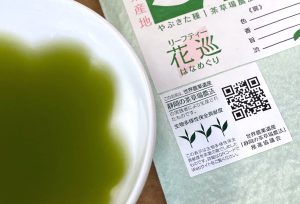
A label which shows contribution degree of biodiversity on the package of tea
Related article on the site:
Tea related facilities:
粟ヶ岳茶文字
粟ヶ岳世界農業遺産茶草場テラス(かっぽしテラス)
ふじのくに茶の都ミュージアム https://tea-museum.jp
KADODE OOIGAWA (かどでおおいがわ) https://kadode-ooigawa.j
Reference:
The Food and Agriculture Organization (FAO), GIAHS Globally Important Agricultural Heritage System
http://www.fao.org/giahs/en/
FAO, GIAHS Globally Important Agricultural Heritage System, Traditional Tea-grass Integrated System in Shizuoka
https://www.fao.org/giahs/giahsaroundtheworld/designated-sites/asia-and-the-pacific/traditional-tea-grass-integrated-system-in-shizuoka/en/
FAO駐日連絡事務所 Liaison Office in Japan
http://www.fao.org/japan/en/
GIAHSとは?
http://www.fao.org/japan/portal-sites/giahs/en/
農林水産省HP、世界農業遺産Globally Important Agricultural Heritage Systems (GHIAS)
www.maff.go.jp/j/nousin/kantai/giahs_1_1.html
世界農業遺産、静岡の茶草場農法 http://www.chagusaba.jp/
*The information provided on this site may be updated. If you find any information in this article that is incorrect, new, or incomplete, please contact CHAMART.
#GIAHS #CHAGUSABA